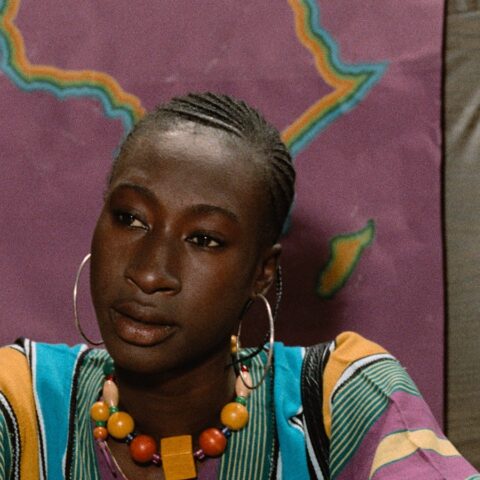By Simone Drake | with thanks to NewBlackMan (in Exile)
Â
Â
Tuesday, July 29, 2014.
Â
I made a last-minute decision that my family and I would travel to Brooklyn to see Kara Walker’s art installation, “A Subtlety, or the Marvelous Sugar Baby…,” at the now defunct Domino Sugar Refinery. I decided I needed to see the installation in person, because I have published on Walker’s antebellum silhouettes, and I was intrigued by Facebook posts of numerous fellow academic-friends and the general controversy that surrounds much, but interestingly not all, of Walker’s art. The lines to see the installation were famously long, and on the second to last day, which is when I went, the line trailed further than the eye could see.Â
When my family finally entered the factory, I cannot say the experience lived up to the hype. Yes, being there in person allowed me to see the carbon and carmelized sugar coating on the factory walls as a living memory of the troubling production process Walker signifies upon in the installation’s title. And, yes, being there allowed me the first-hand experience of observing how others experienced the exhibit—both those in awe, as well as those who elected to pose in front of the ultra white, upward turned buttocks and vulva of the mammie-sphinx. But the installation itself simply did not elicit for me what the hype proposed it ought to, and in the end, I found two other observations during my stay in NYC to be more interesting than Sugar Baby.
My husband and I could have—and as we felt on a number of occasions during our six-day visit, probably should have—left our three sons (age 3.5, 8, and 10.5) with grandparents and enjoyed an always-needed getaway by ourselves. Our investment in our children experiencing as many different places and people as possible, however, compels us to take them nearly everywhere with us, even when they are not always appreciative of the experiences. My children were not appreciative of the long walk from the subway station to the factory, and then to the end of the seemingly endless entry line.Â
Upon entering the plant, they seemed unimpressed by the Sugar Baby. Or perhaps her grandiosity was minimized by the sensorial experience of walking through the threshold and being struck by the stench of rotting sugar. As my children observed the dim and dank space and repeatedly said, “What’s that smell—it stinks in here,” the oldest asked the middle brother: “Would you ever want to work in a sugar factory?” The immediate response was, “No!” Their youthful innocence did not obstruct an ability to register the living history of the inhumanity of both the Trans-Atlantic slave trade that produced the sugarcane production labor initially or the exploitative labor of the largely immigrant population who refined it into the early twenty-first century.
My husband and I took a lot of pictures of both Sugar Baby and the plant that housed her, while our children also took pictures; their pictures were almost entirely of one another and of the molasses-resin black boys that were strewn throughout the space, carrying baskets and bananas. Perhaps because the molasses-boys were boys like themselves, or perhaps because they were close to their height and were not roped off, allowing close observation of the boys and the contents of the baskets, our sons directed most of their attention to the mammie-sphinx’s attendants and not the mammie-sphinx herself; they did not seem to register the risqué details of Sugar Baby. Their disinterest in what was intended as spectacle, and interest in the more ironic symbolism of the byproduct of refining sugarcane in many ways seems to capture a greater nuance of the subtleties of Walker’s work than the Sugar Baby in all her grandiose and perspicuous glory.
Their nuanced observations and attentiveness to what Walker reduced to tchotchkes—a Yiddish word for trinket or bauble that is used to describe the boys—resonated with two other experiences during our visit: Brooklyn’s International African Arts Festival (IAAF) and the American Museum of Natural History (AMNH). Marketed as “an outdoor African cultural oasis,” there were two things that struck me about the fair. Nearly every “art” vendor was selling the same mass-produced “trinkets.” The other thing I could not help but notice was the food vendors were primarily selling Caribbean cuisine; I only saw one West African food vendor (much different than my experience at Chicago’s African Festival of the Arts). There is nothing wrong with a Diasporic infusion, but I could not help but feel a commodification and consumption of culture that resonates with Walker’s critique of the sugar trade. Africa—the vast continent—seemed more to be up for sale than to be a set of diverse cultures to experience creatively.
At the AMNH, the zoological and anthropological collections at the museum are at once fascinating and disturbing. It is fascinating to see species of animals one is not likely to see in person. It is also fascinating to learn about other cultures and time periods. It is, however, a disturbing observance to note the curatorial politics of the exhibits in the “Cultural Halls.” The cultural halls examine the cultures of Asia, Africa, North and South America, and the Pacific. The non-Western focus of the cultural halls could seem refreshing given Georg Hegel’s positioning of Africa outside of culture, declaring it to be without history and with “no movement or development to exhibit […] still involved in the conditions of mere nature.” The culture presented nonetheless positions non-Western cultures as pre-modern through its focus on ancient civilizations.Â
The focus on antiquity would not emphasize Hegel’s scientific racism if Europe was not conspicuously absent from the cultural halls. By failing to include an exhibit featuring Europe’s ancient civilizations, it is implied that Europe was always modern—always at the pinnacle of the “great chain of being,” just as popular race science at the time of the museum’s founding insisted. The conspicuous cultural absence of Europe is compounded by its only reference being in the Hall of Human Origins, inserting Europe, again, at the pinnacle of humanity; and surely the omnipotent presence of Theodore Roosevelt throughout the museum—through both a $40 million dollar renovation of the Rotunda and Memorial Hall in his honor, as well as the statue of Roosevelt on a horse, flanked by a partially clothed Native American and African man at the museum’s main entrance—contrast “civilized” whiteness to the fixed state of nature non-white cultures exist in and depicted in the museum halls.
Although embracing different missions, the IAAF and the AMNH reduced Africa and its cultures to trinkets to be bought and consumed, making me, again, think about the molasses boys more than the Sugar Baby. Rain and hot temperatures resulted in some of the molasses boys “not making it.” Several molasses boys were pushed off to the side against the plant walls. They lay there in shattered pieces, victims of the climate and no longer useful. While I see their brokenness as symbolic of the history Walker uses them to critique, their brokenness seemingly rendered them unusable by those maintaining the exhibit. The discarding of the molasses boys speaks to a global phenomenon of treating blackness as a commodity whose value is elevated only when it serves the interest of a public whose greatest interest is in profit rather than cultural appreciation. I am glad my children’s critical thinking skills registered this phenomenon.
***
Â
Simone Drake is an assistant professor of African American and African Studies at The Ohio State University. She is the author of Critical Appropriations: African American Women and the Construction of Transnational Identity (2014).




Magnificent website. A lot of useful information here. I?¦m sending it to several friends ans additionally sharing in delicious. And obviously, thank you for your sweat!
I’m impressed, I must say. Actually rarely do I encounter a blog that’s each educative and entertaining, and let me inform you, you will have hit the nail on the head. Your thought is excellent; the problem is one thing that not sufficient people are talking intelligently about. I am very joyful that I stumbled throughout this in my search for something regarding this.
Hmm it seems like your blog ate my first comment (it was super long) so I guess I’ll just sum it up what I submitted and say, I’m thoroughly enjoying your blog. I too am an aspiring blog blogger but I’m still new to the whole thing. Do you have any suggestions for first-time blog writers? I’d genuinely appreciate it.
Thanks, I have recently been searching for info approximately this topic for a long time and yours is the best I’ve found out till now. But, what about the bottom line? Are you sure about the source?
I was curious if you ever thought of changing the page layout of your website? Its very well written; I love what youve got to say. But maybe you could a little more in the way of content so people could connect with it better. Youve got an awful lot of text for only having 1 or two pictures. Maybe you could space it out better?